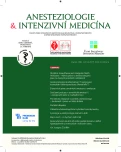-
Medical journals
- Career
A brief review of obstetrics analgesia practised in the United Kingdom
Authors: Matloch Zdeněk 1,2; Matlochová Sylvie 1
Authors‘ workplace: South Devon Healthcare NHS Trust, Torbay District General Hospital, Devon, United Kingdom 1; Klinika anesteziologie a resuscitace, Kardiocentrum, Institut klinické a experimentální medicíny, Praha 2
Published in: Anest. intenziv. Med., 24, 2013, č. 2, s. 102-106
Category: Postgraduate education
Overview
There are several techniques of labour analgesia. Non-regional techniques have predominantly supportive role and inhalation of Entonox is preferred over systemic opioid administration. Inhalation of Entonox is very popular in the United Kingdom. It provides reasonable analgesia and is suitable mainly in hospitals where other analgesic options are limited. The Entonox is being self-administered by the parturients which also provides a certain degree of satisfaction. The gold standard among regional techniques is epidural analgesia, offering the best analgesia. Several recently conducted randomised controlled trials confirm that epidural analgesia is not associated with an increased incidence of LSCS (Low Segment Caesarean Section) or backache after childbirth. However, several studies have demonstrated a modest prolongation of the second stage of labour and an increase in the operative vaginal delivery rate. Remifentanil PCA is a relatively new method of labour analgesia and is mainly indicated for mothers in whom epidural analgesia is contraindicated or difficult/impossible to establish.
Keywords:
labour analgesia – Entonox – Remifentanil – epidural analgesia
Sources
1. www.frca.co.uk
2. Guidelines South Devon Healthcare NHS Trust
3. Peck, T. E., Hill, S. A., Williams, M. Pharmacology for Anaes-thesia and Intensive Care. Third Edition, Cambridge Press, 2008, p. 121.
4. Al-Shaikh, B., Stacey, S. Essentials of Anaesthetic Equipment. Churchill Livingstone Elsevier, 2007, p. 10–11.
5. Glass, P. S. A., Hardman, D., Kamayama, Y. et al. Preliminary pharmakokinetics and pharmacodynamics of an ultra-shortacting opioid: Remifentanil. Anaesthesia Analgesia, 1993, 77, s. 1031–1040.
6. Amin, H. M., Soopchak, A. M., Esposito, R. N., Graham, C. L., Batenhurst, R. L., Camporesi, E. M. Naloxone reversal of depressed ventilatory response to hypoxia during continuous infusion of Remifentanil. Anaesthesiology, 1993, 79, p. 1203.
7. Kan, R. E., Hughes, S. C., Rosen, M. A. et al. Intravenous Remifentanil: Placental transfer, maternal and neonatal effects. Anaesthesiology, 1998, 88, p. 1467–1479.
8. Thurlow, J. A., Waterhouse, P. Patient controlled analgesia in labour using Remifentanil in two parturients with platelet abnormalities. British Journal of Anaesthesiology, 2000, 84, p. 411–413.
9. Jones, R., Pegrum, A., Stacey, R. G. W. Patient controlled analgesia using Remifentanil in the parturient with thrombocytopaenia. Anaesthesia, 1999, 54, p. 459–465.
10. Olufalabi, A. J., Booth, J. V., Wakeling, H. G. et al. A preliminary investigation of Remifentanil as a labour analgesic. Anaesthesia Analgesia, 2000, 92, p. 606–608.
Labels
Anaesthesiology, Resuscitation and Inten Intensive Care Medicine
Article was published inAnaesthesiology and Intensive Care Medicine

2013 Issue 2
Most read in this issue- Current Practice in obstetric anaesthesia I. – peri-operative care in Caesarean Section
- A brief review of obstetrics analgesia practised in the United Kingdom
- Anaesthesia for CT-navigated irreversible electroporation (NanoKnifeTM)
Login#ADS_BOTTOM_SCRIPTS#Forgotten passwordEnter the email address that you registered with. We will send you instructions on how to set a new password.
- Career

